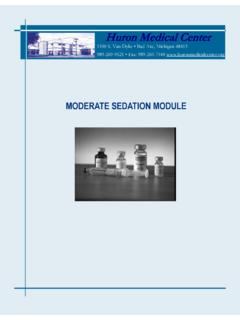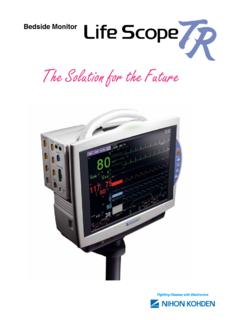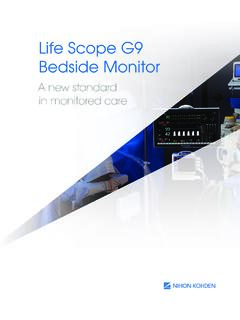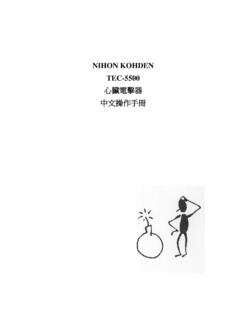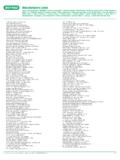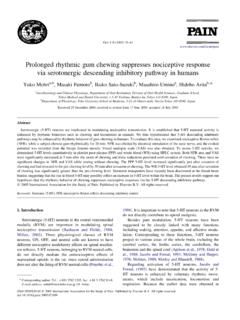Transcription of Telemetry Monitoring For Nurses and Monitor …
1 nihon kohden America is a subsidiary of 90 Icon Street Foothill Ranch CA 92610 Telemetry Monitoring For Nurses and Monitor Technicians May, 2011 Telemetry ECG Monitoring for Nurses and Monitor Technicians May 2011 2 of 18 Purpose This self-study packet is designed to introduce the Telemetry Monitoring users to the
2 Basic principles and procedures for ECG Monitoring on the nihon kohden Telemetry system. Learning Objectives By completing this self-study packet, you will be able to: 1. Describe proper ECG electrode placement and skin preparation procedures for continuous ECG Monitoring . 2. Discuss the ST-segment Monitoring capabilities. 3. Describe the cleaning procedures and interventions for troubleshooting ECG Monitoring issues. Introduction The 12-lead ECG is used to help identify primary conduction abnormalities, arrhythmias, cardiac hypertrophy, pericarditis, electrolyte imbalances, myocardial infarction or ischemia, and the site and extent of these disorders.
3 The benefits of the 12-lead are expanded as we continuously Monitor this ECG tracing on the bedside and Telemetry Monitoring systems today. This packet will quickly review the cardiac anatomy, and describe how the ECG tracing correlates to it. It will review how the Telemetry Monitor processes the ECG waveform for heart rate and arrhythmias, and for pacemaker detection, and lastly, it will discuss the ST-segment Monitoring capabilities on the nihon kohden Telemetry system. The way that this heart is stimulated to pump is through its own internal electrical system; the heart s generator if you will.
4 This electrical system consists of impulse generator cells, as well as impulse conductor cells that conduct these impulses to the myocardium to stimulate it to contract and pump the blood. The Sino-atrial (SA) node, which is located high in the right atrium, is the normal pacemaker in the heart that sets the rhythm and rate for the cardiac function. Once the impulse is generated in the SA node, it spreads throughout the atria and down to the Atrio-Ventricular (AV) node, where is it held so that the atria can contract.
5 When the impulse leaves the AV node, it travels through the Bundle of His, down through the right and left Bundle branches to the Purkinje fibers that are in contact with the ventricular myocardium. Once these cells are stimulated, they contract and squeeze the blood from the ventricles and out to the body. It is this ventricular contraction that produces the palpable pulses. The electrical activity MUST precede the mechanical activity, so it is the electrical activity that we capture on the Monitor as the ECG signal, NOT the mechanical contraction that generates the pulse.
6 The Electrocardiogram The electrocardiogram (ECG) is the electrical activity that is captured by placing conductive electrodes onto the patient. As the impulses travel throughout the heart s chambers, specific components are produced on the ECG. The p-wave represents atrial depolarization, which are the electrical changes that are required in order for the muscle to contract. The PR segment represents the length of time that the impulse is held in the AV node and Bundle of His before it proceeds through to the Bundle branches.
7 The QRS represents the wave of ventricular depolarization as it travels through the right and left Bundle branches and the Purkinje fibers to stimulate these cells. The t-wave represents ventricular depolarization, where the myocardial cells return to the normal electrical state and prepare to receive the next impulse. Our interest lies in the lengths of time that it takes for each of these events to occur, and the normal times are listed below. Telemetry ECG Monitoring for Nurses and Monitor Technicians May 2011 3 of 18 ECG Electrode Placement In order to capture this electrical signal from
8 Within the patient, we must place conductive electrodes on strategic positions on the body, and the exact placement is crucial to accurate interpretation. Since the heart rests within the patient s chest, for continuous ECG Monitoring , we place the electrodes on the chest, at the mid-clavicular lines and at the anterior axillary lines on the lower ribs. Each lead wire is labeled for the anatomical position, such as right arm (RA), left arm (LA), right leg (RL), left leg (LL), and Chest (V) 1-6. Placing them in these positions minimizes motion artifact and provides for good quality tracings.
9 The exact placement is delineated below, with the V1 and V3 positions used with the six electrode sets. ST Segment Another component of the ECG is the ST segment. This represents the beginning of ventricular repolarization, and should be a flat portion of the tracing. This is referred to as isoelectric , and it is considered to be abnormal when it is elevated or depressed. Either of these conditions indicates an abnormal and/or ischemic condition within the myocardial cells.
10 ST ST --Segment MeasurementSegment MeasurementIsoelectric lineIsoelectric lineST ST --segment segment relative to isoelectricrelative to isoelectricNormally measured in millimeters Normally measured in millimeters Intervals: PR = to .20 seconds QRS = < seconds QT = < seconds ST Segment Another component of the ECG is the ST segment. This represents the beginning of ventricular repolarization, and should be a flat portion of the tracing.
